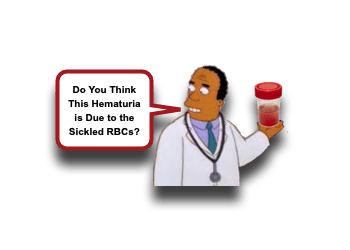Renal Papillary Necrosis and Sickle Cell Disease

Blood shooting out of the urethra will catch people’s attention! While it may be due to a relatively benign issue, there are a number of considerations that immediately come to our minds: Renal Trauma, Abdominal Trauma, Renal Stones, UTI. While these should be considered in anyone with hematuria, some medical conditions introduce additional problems. Thanks to our fantastic PEM Fellow Dr. Mary Grady, I was reminded of this recently. Let us take a minute to review the interplay of a condition we commonly encounter and hematuria – Renal Papillary Necrosis and Sickle Cell Disease:
Gross Hematuria
- Gross vs Microscopic
- Gross hematuria, unlike microscopic, is more likely to be associated with an identifiable cause.
- Gross hematuria considerations:
- UTI,
- Trauma,
- Nephrolithiasis,
- Coagulopathies,
- Crystalluria, and
- Renal disease.
- Gross hematuria associated with edema/proteinuria and/or hypertension warrants concern for renal disease, like Post-Infectious Glomerulonephritis. [Davis, 2015]
- Hematuria in children is less likely to be a Urologic issue than in adults. [Massengill, 2008]
Renal Papillary Necrosis
- Renal Papillary Necrosis is not a pathologic entity… it is a descriptive term used for necrosis of the renal papillae (duh). [Jung, 2006]
- Incidence is up to 50% in patients with Sickle Cell Trait.
- Presentation:
- Hematuria
- Dysuria
- Flank / Abdominal Pain (due to sloughing of papillae)
- Acute Renal Failure (may need dialysis)
- Overt Sepsis
- Conditions that cause increase risk for ischemia can lead to RPN [Henderickx, 2017; Jung, 2006; Griffin, 1995]:
- Pediatric cases are most often related to:
- Sickle Cell Disease
- Perinatal ischemia
- Neonatal dehydration
- Sepsis
- A few other risk factors (most typically seen in adults):
- Diabetes
- Analgesic Abuse
- Pyelonephritis
- Urinary Tract Obstruction
- Renal Vein Thrombosis
- Systemic Vasculitis
- Often these risk factors overlap. [Griffin, 1995]
- Pediatric cases are most often related to:
Renal Papillary Necrosis & Sickle Cell Disease
- Sickle Cell Disease (SSD) is particularly harsh on the kidneys: Sickled RBCs in small blood vessels lead to vascular stasis and tissue ischemia. [Henderickx, 2017]
- Kidney physiology and anatomy exacerbates sickling of RBCs: [Henderickx, 2017]
- Low oxygen levels and HYPERosmolarity of the renal medulla exacerbate the sickling of RBCs.
- The vasa recta carry blood through the medullary tissue, but at a very low flow rate – prolonging exposure of RBCs to hypertonic environment.
- The renal medulla and papillae are very vulnerable to ischemia.
Renal Papillary Necrosis: Evaluation
- RPN should not be at the top of the Ddx, and only attributed after other concerns have been eliminated. [Henderickx, 2017]
- For Hematuria presenting in patient with Sickle Cell Disease: [Henderickx, 2017]
- Check Urine Culture and Urinalysis
- Check Renal Function (BUN/Cr) and Electrolytes
- Complement C3, CRP, and Spot Urine Ca/Cr ratio are also helpful.
- Consider imaging:
- Renal U/S can be helpful to look for stones and/or hydronephrosis.
- CT with IV contrast during excretion phase help to define features of RPN. [Sutariya, 2016; Jung, 2006]
- MRI has also been used to Diagnose RPN.
- Management of RPN with Sickle Cell Disease: [Henderickx, 2017]
- Hydration – improve renal perfusion
- Blood transfusions to improve ratio of Adult Hgb (but consult hematologist first)
- Broad spectrum antibiotics
- Correction of electrolyte derangements
- Urine Alkalinization – may not be started initially, but usually a part of the management
- Massive hemorrhage may require nephrectomy.
Moral of the Morsel
- Sickle Cell Disease is a terrible condition! Sickled RBCs and fragile, tiny blood vessels don’t go well.
- Sickled RBCs and the Kidney medulla don’t get a long! The physiology and anatomy conspire to lead to local ischemia!
- The “typical stuff” first… then Renal Papillary Necrosis. While RPN needs to be on the DDX, focus on eliminating the other potential causes first.
References
Henderickx MMEL1, Brits T2, De Baets K2, Seghers M3, Maes P4, Trouet D4, De Wachter S2, De Win G2. Renal papillary necrosis in patients with sickle cell disease: How to recognize this ‘forgotten’ diagnosis. J Pediatr Urol. 2017 Jun;13(3):250-256. PMID: 28341428. [PubMed] [Read by QxMD]
Davis TK1, Hmiel P2. Pediatric Hematuria Remains a Clinical Dilemma. Clin Pediatr (Phila). 2015 Aug;54(9):817-30. PMID: 25253774. [PubMed] [Read by QxMD]
Li EJ1, Carroll VG2. Sickle cell trait and renal papillary necrosis. Clin Pediatr (Phila). 2014 Sep;53(10):1013-5. PMID: 24807983. [PubMed] [Read by QxMD]
Gabrovsky A1, Aderinto A, Spevak M, Vichinsky E, Resar LM. Low dose, oral epsilon aminocaproic acid for renal papillary necrosis and massive hemorrhage in hemoglobin SC disease. Pediatr Blood Cancer. 2010 Jan;54(1):148-50. PMID: 19785026. [PubMed] [Read by QxMD]
Massengill SF1. Hematuria. Pediatr Rev. 2008 Oct;29(10):342-8. PMID: 18829770. [PubMed] [Read by QxMD]
Jung DC1, Kim SH, Jung SI, Hwang SI, Kim SH. Renal papillary necrosis: review and comparison of findings at multi-detector row CT and intravenous urography. Radiographics. 2006 Nov-Dec;26(6):1827-36. PMID: 17102053. [PubMed] [Read by QxMD]
de Santis Feltran L1, de Abreu Carvalhaes JT, Sesso R. Renal complications of sickle cell disease: managing for optimal outcomes. Paediatr Drugs. 2002;4(1):29-36. PMID: 11817984. [PubMed] [Read by QxMD]
Griffin MD1, Bergstralhn EJ, Larson TS. Renal papillary necrosis–a sixteen-year clinical experience. J Am Soc Nephrol. 1995 Aug;6(2):248-56. PMID: 7579092. [PubMed] [Read by QxMD]

